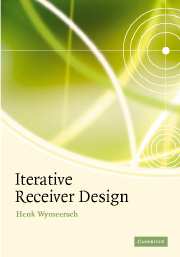Book contents
- Frontmatter
- Contents
- Preface
- Abbreviations
- Notations
- List of algorithms
- 1 Introduction
- 2 Digital communication
- 3 Estimation theory and Monte Carlo techniques
- 4 Factor graphs and the sum–product algorithm
- 5 Statistical inference using factor graphs
- 6 State-space models
- 7 Factor graphs in digital communication
- 8 Decoding
- 9 Demapping
- 10 Equalization–general formulation
- 11 Equalization: single-user, single-antenna communication
- 12 Equalization: multi-antenna communication
- 13 Equalization: multi-user communication
- 14 Synchronization and channel estimation
- 15 Appendices
- References
- Index
6 - State-space models
Published online by Cambridge University Press: 08 January 2010
- Frontmatter
- Contents
- Preface
- Abbreviations
- Notations
- List of algorithms
- 1 Introduction
- 2 Digital communication
- 3 Estimation theory and Monte Carlo techniques
- 4 Factor graphs and the sum–product algorithm
- 5 Statistical inference using factor graphs
- 6 State-space models
- 7 Factor graphs in digital communication
- 8 Decoding
- 9 Demapping
- 10 Equalization–general formulation
- 11 Equalization: single-user, single-antenna communication
- 12 Equalization: multi-antenna communication
- 13 Equalization: multi-user communication
- 14 Synchronization and channel estimation
- 15 Appendices
- References
- Index
Summary
Introduction
State-space models (SSMs) are a mathematical abstraction of many real-life dynamic systems. They have been proven to be useful in a wide variety of fields, including robot tracking, speech processing, control systems, stock prediction, and bio-informatics, basically anywhere there is a dynamic system [70–75]. These models are not only of great practical relevance, but also a good illustration of the power of factor graphs and the SPA. The central idea behind an SSM is that the system at any given time can be described by a state, belonging to a state space. The state space can be either discrete or continuous. The state changes dynamically over time according to a known statistical rule. We cannot observe the state directly; the state is said to be hidden. Instead we observe another quantity (the observation), which has a known statistical relationship with the state. Once we have collected a sequence of observations, our goal is to infer the corresponding sequence of states.
This chapter is organized as follows.
In Section 6.2 we will describe the basic concepts of SSMs, create an appropriate factor graph, and show how the sum–product and max–sum algorithms can be executed on this factor graph. Then, we will consider three cases of SSM in detail.
In Section 6.3, we will cover models with discrete state spaces, known as hidden Markov models (HMMs), where we reformulate the well-known forward–backward and Viterbi algorithms using factor graphs.
[…]
- Type
- Chapter
- Information
- Iterative Receiver Design , pp. 105 - 134Publisher: Cambridge University PressPrint publication year: 2007



